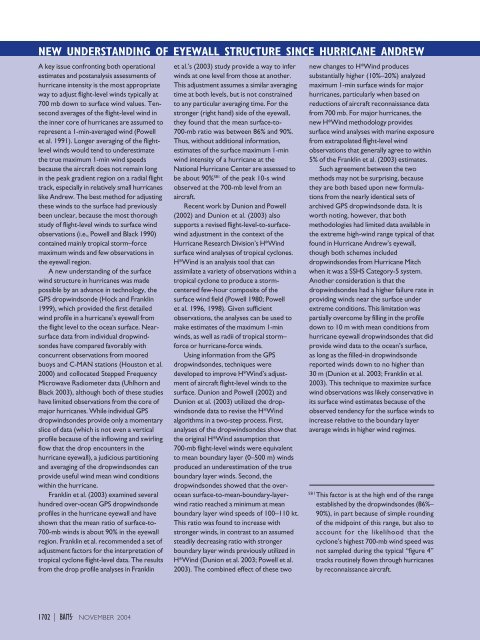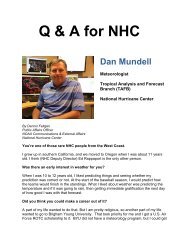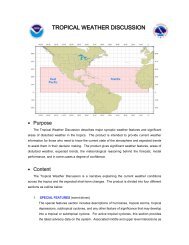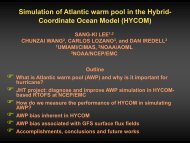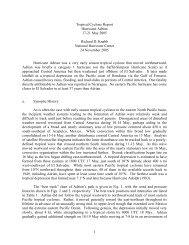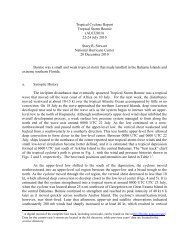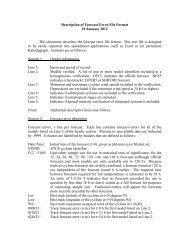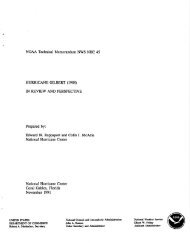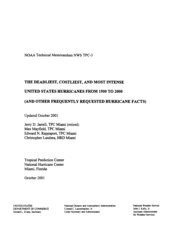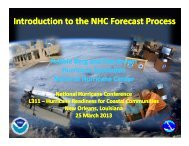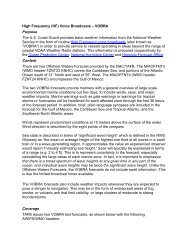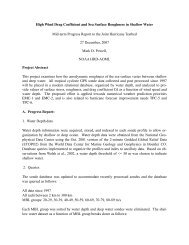A REANALYSIS OF HURRICANE ANDREW'S INTENSITY - National ...
A REANALYSIS OF HURRICANE ANDREW'S INTENSITY - National ...
A REANALYSIS OF HURRICANE ANDREW'S INTENSITY - National ...
Create successful ePaper yourself
Turn your PDF publications into a flip-book with our unique Google optimized e-Paper software.
NEW UNDERSTANDING <strong>OF</strong> EYEWALL STRUCTURE SINCE <strong>HURRICANE</strong> ANDREW<br />
A key issue confronting both operational<br />
estimates and postanalysis assessments of<br />
hurricane intensity is the most appropriate<br />
way to adjust flight-level winds typically at<br />
700 mb down to surface wind values. Tensecond<br />
averages of the flight-level wind in<br />
the inner core of hurricanes are assumed to<br />
represent a 1-min-averaged wind (Powell<br />
et al. 1991). Longer averaging of the flightlevel<br />
winds would tend to underestimate<br />
the true maximum 1-min wind speeds<br />
because the aircraft does not remain long<br />
in the peak gradient region on a radial flight<br />
track, especially in relatively small hurricanes<br />
like Andrew. The best method for adjusting<br />
these winds to the surface had previously<br />
been unclear, because the most thorough<br />
study of flight-level winds to surface wind<br />
observations (i.e., Powell and Black 1990)<br />
contained mainly tropical storm–force<br />
maximum winds and few observations in<br />
the eyewall region.<br />
A new understanding of the surface<br />
wind structure in hurricanes was made<br />
possible by an advance in technology, the<br />
GPS dropwindsonde (Hock and Franklin<br />
1999), which provided the first detailed<br />
wind profile in a hurricane’s eyewall from<br />
the flight level to the ocean surface. Nearsurface<br />
data from individual dropwindsondes<br />
have compared favorably with<br />
concurrent observations from moored<br />
buoys and C-MAN stations (Houston et al.<br />
2000) and collocated Stepped Frequency<br />
Microwave Radiometer data (Uhlhorn and<br />
Black 2003), although both of these studies<br />
have limited observations from the core of<br />
major hurricanes. While individual GPS<br />
dropwindsondes provide only a momentary<br />
slice of data (which is not even a vertical<br />
profile because of the inflowing and swirling<br />
flow that the drop encounters in the<br />
hurricane eyewall), a judicious partitioning<br />
and averaging of the dropwindsondes can<br />
provide useful wind mean wind conditions<br />
within the hurricane.<br />
Franklin et al. (2003) examined several<br />
hundred over-ocean GPS dropwindsonde<br />
profiles in the hurricane eyewall and have<br />
shown that the mean ratio of surface-to-<br />
700-mb winds is about 90% in the eyewall<br />
region. Franklin et al. recommended a set of<br />
adjustment factors for the interpretation of<br />
tropical cyclone flight-level data. The results<br />
from the drop profile analyses in Franklin<br />
et al.’s (2003) study provide a way to infer<br />
winds at one level from those at another.<br />
This adjustment assumes a similar averaging<br />
time at both levels, but is not constrained<br />
to any particular averaging time. For the<br />
stronger (right hand) side of the eyewall,<br />
they found that the mean surface-to-<br />
700-mb ratio was between 86% and 90%.<br />
Thus, without additional information,<br />
estimates of the surface maximum 1-min<br />
wind intensity of a hurricane at the<br />
<strong>National</strong> Hurricane Center are assessed to<br />
be about 90% SB1 of the peak 10-s wind<br />
observed at the 700-mb level from an<br />
aircraft.<br />
Recent work by Dunion and Powell<br />
(2002) and Dunion et al. (2003) also<br />
supports a revised flight-level-to-surfacewind<br />
adjustment in the context of the<br />
Hurricane Research Division’s H*Wind<br />
surface wind analyses of tropical cyclones.<br />
H*Wind is an analysis tool that can<br />
assimilate a variety of observations within a<br />
tropical cyclone to produce a stormcentered<br />
few-hour composite of the<br />
surface wind field (Powell 1980; Powell<br />
et al. 1996, 1998). Given sufficient<br />
observations, the analyses can be used to<br />
make estimates of the maximum 1-min<br />
winds, as well as radii of tropical storm–<br />
force or hurricane-force winds.<br />
Using information from the GPS<br />
dropwindsondes, techniques were<br />
developed to improve H*Wind’s adjustment<br />
of aircraft flight-level winds to the<br />
surface. Dunion and Powell (2002) and<br />
Dunion et al. (2003) utilized the dropwindsonde<br />
data to revise the H*Wind<br />
algorithms in a two-step process. First,<br />
analyses of the dropwindsondes show that<br />
the original H*Wind assumption that<br />
700-mb flight-level winds were equivalent<br />
to mean boundary layer (0–500 m) winds<br />
produced an underestimation of the true<br />
boundary layer winds. Second, the<br />
dropwindsondes showed that the overocean<br />
surface-to-mean-boundary-layerwind<br />
ratio reached a minimum at mean<br />
boundary layer wind speeds of 100–110 kt.<br />
This ratio was found to increase with<br />
stronger winds, in contrast to an assumed<br />
steadily decreasing ratio with stronger<br />
boundary layer winds previously utilized in<br />
H*Wind (Dunion et al. 2003; Powell et al.<br />
2003). The combined effect of these two<br />
new changes to H*Wind produces<br />
substantially higher (10%–20%) analyzed<br />
maximum 1-min surface winds for major<br />
hurricanes, particularly when based on<br />
reductions of aircraft reconnaissance data<br />
from 700 mb. For major hurricanes, the<br />
new H*Wind methodology provides<br />
surface wind analyses with marine exposure<br />
from extrapolated flight-level wind<br />
observations that generally agree to within<br />
5% of the Franklin et al. (2003) estimates.<br />
Such agreement between the two<br />
methods may not be surprising, because<br />
they are both based upon new formulations<br />
from the nearly identical sets of<br />
archived GPS dropwindsonde data. It is<br />
worth noting, however, that both<br />
methodologies had limited data available in<br />
the extreme high-wind range typical of that<br />
found in Hurricane Andrew’s eyewall,<br />
though both schemes included<br />
dropwindsondes from Hurricane Mitch<br />
when it was a SSHS Category-5 system.<br />
Another consideration is that the<br />
dropwindsondes had a higher failure rate in<br />
providing winds near the surface under<br />
extreme conditions. This limitation was<br />
partially overcome by filling in the profile<br />
down to 10 m with mean conditions from<br />
hurricane eyewall dropwindsondes that did<br />
provide wind data to the ocean’s surface,<br />
as long as the filled-in dropwindsonde<br />
reported winds down to no higher than<br />
30 m (Dunion et al. 2003; Franklin et al.<br />
2003). This technique to maximize surface<br />
wind observations was likely conservative in<br />
its surface wind estimates because of the<br />
observed tendency for the surface winds to<br />
increase relative to the boundary layer<br />
average winds in higher wind regimes.<br />
SB1<br />
This factor is at the high end of the range<br />
established by the dropwindsondes (86%–<br />
90%), in part because of simple rounding<br />
of the midpoint of this range, but also to<br />
account for the likelihood that the<br />
cyclone’s highest 700-mb wind speed was<br />
not sampled during the typical “figure 4”<br />
tracks routinely flown through hurricanes<br />
by reconnaissance aircraft.<br />
1702 | NOVEMBER 2004


